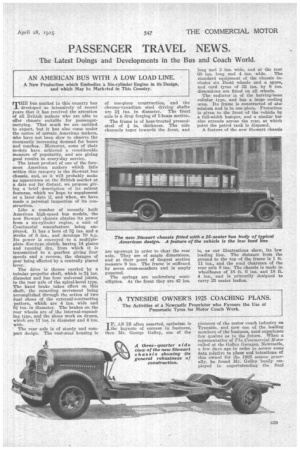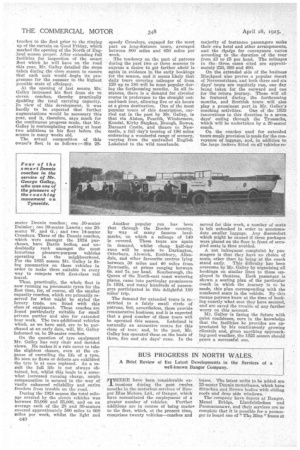A TYNESIDE OWNER'S 1925 COACHING PLANS.
Page 23

Page 24

If you've noticed an error in this article please click here to report it so we can fix it.
The Activities of a Newcastle Proprietor who Favours the Use of Pneumatic Tyres for Motor Coach Work.
IF, AS IS often asserted, optimism is the keynote of success in business, then Mr. George Galley, one of the pioneers of the motor coach industry on Tyneside, and now one of the leading members of the business, need experience few qualms as to the future. When a representative of The Commercial Motor called at the Galley Garages, Newcastle, a few days ago in order to secure some data relative to plans and intentions of this owned for the 1925 seasen generally, he found Mr. Galley busily employed in superintending the final touches to the fleet prior to the ringing up of the curtain on Good Friday, -which marked the opening of the North of England season proper. After extending full facilities for inspection of the smart fleet which he will have on the road this year, Mr. Galley detailed the steps taken during the close season to ensure that each unit would -begin its programme for the summer in the highest possible state of efficiency.
At the opening of last season Mr.' Galley increased his fleet from six to eleven coaches, thereby practically d,publing the total carrying capacity. In view of this development, it was hardly to be expected that further augmentations would be necessary this year, and it, therefore, says much for the continuous progress made, that Mr. Galley is contemplating making at least two additions to his fleet before the season is many weeks old.
The actual composition of this owner's fleet is as follows :—Sim 28
seater Dennis coaches ; one 30-seater Daimler ; one 20-seater La.ncia ; one 20seater W. and G.; and two 14-seater Crossleys. Three of the Dennis coaches, which were amongst the 1924 purchases, have Bartle bodies, and undoubtedly rank amongst the most luxurious pleasure-purpose vehicles operating in the neighbourhood. For the 1925 season Mr. Galley is fitlug pneumatics on these vehicles in order to make them suitable in every way to compete with first-class rail travel.
Thus, practically, the whole fleet is now running on pneumatic tyres for the first time, for, of course, all the smaller capacity coaches, which are primarily reserved for what might be styled the luxury trade, are fitted with this class of equipment. These coaches are found particularly suitable for small private parties and also for extended tour work. The two additional vehicles which, as we have said, are to be purchased at an early date, will, Mr. Galley Informed us, be 20-seater coaches.
On the question of tyre equipment Mr. Galley has very clear and decided views. He makes it a rule never to take the slightest chance, even at the expense of curtailing the life of a tyre. So soon as flaws or defects are exhibited the tyre is at once replaced. As a result the full life is not always obtained, but, whilst this leads to a somewhat increased running charge, ample compensation is secured in the way of vastly enhanced reliability and entire freedom from trouble on the road.
During the 1924 season the total mileage covered by the eleven vehicles was between 50,000 and 55,000, and on an average each of the 28 and 30-seaters covered approximately 500 miles to 600 miles per week, whilst the light and 040 speedy Crossleys, engaged for the most part on long-distance tours, averaged between 800 miles and 850 miles per week.
The tendency on the part of patrons during the past two or three seasons to express a desire to get farther afield is again in evidence in the early bookings for the season, and it seems likely that daily tours covering mileages of from 120 up to 180 will be most popular during the forthcoming months. In all instances, there is a demand for circular routes in preference to the straight outand-back tour, allowing five or six hours at a given destination. One of the most popular, tours of this description, carried out in the past by Mr. Galley, is that via Alston, Penrith, Windermere, Kendal, Kirby Stephen, Brough, Bowes, Barnard Castle, and thence to Newcastle, a full day's touring of 196 miles embracing a wonderful range of scenery, varying from the unrivalled English Lakeland to the wild moorlands.
Another popular run has been that through the Border country, by way of many faincius landmarks, on which a mileage of 140 is covered. These tours are again in demand, whilst • cheap half-day runs will be made to Darlington, Otterburn, Alnwick, Rothbury, Allendale, and other favourite centres lying between 30 miles and 40 miles from Newcastle, at prices ranging between 6s. and 7s. per head. Scarborough, the Queen of the North-east coast watering places, came into particular prominence in 1924, and many hundreds of passengers participated in this delightful 180 miles' trip.
The demand for extended tours is re• stricted to a fairly small circle of patrons, but, nevertheless, these provide remunerative business, and it is expected that a good number of these tours will be operated this season. Lakeland is naturally an attractive centre for this class of tour, and, in the past, Mr. Galley has operated these on the basis of three, five and six days' runs. In the majority of instances passengers make their own hotel and other arrangements, and the ekaige for conveyance varies according to the duration of the tour from £3 to £5 per head. The mileages in the three, cases cited are approximately 220, 850 and 400.
On the extended side of the business Blackpool also proves a popular resort of Novocastrians, and both three and six days' tours are regularly run, one day being taken for the outward and one for the' return journey. These will all be featured during, the forthcoming months, and Scottish tours will also play a prominent part in Mr. Galley's coaching activities. One of the 1925 innovations in this direction is a sevendays' outing through the Trossachs, which will be undertaken by a 20-seater coach.
On the coachesused for extended tours ample provision is made for the conveyance of luggage, and, in addition to the large lockers fitted on all vehicles re
served for this work, a number of seats is left unhooked in order to accommodate smaller luggage. Any discomfort which might be caused if these packages were placed on the floor in front of occupied seats is thus avoided.
A not infrequent complaint by passengers is that they have no choice of seats, other than by being at the coach stand early. This difficulty has been overcome by Mr. Galley by organizing all bookings on similar lines to those employed in theatres. Each passenger is shown a seating plan of the particular coach in which the journey is to be made, this plan corresponding with the numbered seats in the vehicle. By this means patrons know at the time of booking exactly what seat they have secured, and are saved the trouble of any further worry on this account.
Mr. Galley is facing the future with quiet confidence, sure in the knowledge that the facilities he provides are appreciated by his continuously growing clientele and, given anything approaching:good weather, the 1925 season should prove a successful one.
































